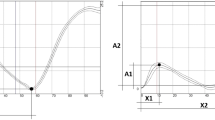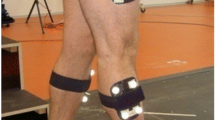Abstract
The purpose of the present study was to investigate whether different walking patterns in healthy subjects and in coper and non-coper subjects with deficient anterior cruciate ligaments could be quantified. An inverse dynamics approach was used to calculate joint kinematics and kinetics for flexion and extension. EMG signals of the hamstrings and quadriceps muscles were recorded. The results showed that the peak knee flexion angle was greater in the copers than in the controls. There was a positive correlation between the peak knee extensor moment and peak knee flexion angle. Furthermore, at a given peak knee flexion angle, the peak knee extensor moment was significantly larger in the controls than in the non-copers. The hip extensor moment in the copers was significantly larger than that of the non-copers and the controls. In conclusion, the three groups walked according to different patterns. It is suggested that the copers stabilized their knee joint by co-contraction of the hamstrings and quadriceps muscles, while the non-copers lacked this ability. Instead, the non-copers reduced the knee extensor moment in order to decrease anterior displacement of the tibia. The walking pattern differences observed between the copers and non-copers may explain their different post-injury activity levels.





Similar content being viewed by others
References
Alkjaer T, Simonsen EB, Dyhre-Poulsen P (2001) Comparison of inverse dynamics calculated by two- and three-dimensional models during walking. Gait Posture 13:73–77
Andriacchi TP, Birac D (1993) Functional testing in the anterior cruciate ligament-deficient knee. Clin Orthop 288:40–47
Beard DJ, Soundarapandian R, O'Connor J, Dodd C (1996) Gait and electromyographic analysis of anterior cruciate ligament deficient subjects. Gait Posture 4:83–88
Berchuck M, Andriacchi TP, Bach BR, Reider B (1990) Gait adaptations by patients who have a deficient anterior cruciate ligament. J Bone Joint Surg Am 72:871–877
Bergmann G, Kniggendorf H, Graichen F, Rohlmann A (1995) Influence of shoes and heel strike on the loading of the hip joint. J Biomech 28:817–827
Boerboom AL, Hof AL, Halbertsma JP, van Raaij JJ, Schenk W, Diercks RL, van Horn JR (2001) Atypical hamstrings electromyographic activity as a compensatory mechanism in anterior cruciate ligament deficiency. Knee Surg Sports Traumatol Arthrosc 9:211–216
Bulgheroni P, Bulgheroni MV, Andrini L, Guffanti P, Giughello A (1997) Gait patterns after anterior cruciate ligament reconstruction. Knee Surg Sports Traumatol Arthrosc 5:14–21
Chmielewski TL, Rudolph KS, Fitzgerald GK, Axe MJ, Snyder-Mackler L (2001) Biomechanical evidence supporting a differential response to acute ACL injury. Clin Biomech (Bristol) 16:586–591
Ciccotti MG, Kerlan RK, Perry J, Pink M (1994) An electromyographic analysis of the knee during functional activities. II. The anterior cruciate ligament-deficient and -reconstructed profiles. Am J Sports Med 22:651–658
Daniel DM, Stone ML, Dobson BE, Fithian DC, Rossman DJ, Kaufman KR (1994) Fate of the ACL-injured patient. A prospective outcome study. Am J Sports Med 22:632–644
Devita P, Hortobagyi T, Barrier J, Torry M, Glover KL, Speroni DL, Money J, Mahar MT (1997) Gait adaptations before and after anterior cruciate ligament reconstruction surgery. Med Sci Sports Exerc 29:853–859
Devita P, Hortobagyi T, Barrier J (1998) Gait biomechanics are not normal after anterior cruciate ligament reconstruction and accelerated rehabilitation. Med Sci Sports Exerc 30:1481–1488
Kaalund S, Lass P, Le Fevre S, Sinkjaer T, Arendt-Nielsen L, Simonsen O (1992) Clinical significance of altered gastrocnemius muscle coordination in anterior cruciate ligament-deficient knees. Scand J Med Sci Sports 2:79–83
Lass P, Kaalund S, leFevre S, Arendt-Nielsen L, Sinkjaer T, Simonsen O (1991) Muscle coordination following rupture of the anterior cruciate ligament. Electromyographic studies of 14 patients. Acta Orthop Scand 62:9–14
Lewek M, Rudolph K, Axe M, Snyder-Mackler L (2002) The effect of insufficient quadriceps strength on gait after anterior cruciate ligament reconstruction. Clin Biomech (Bristol) 17:56–63
Limbird TJ, Shiavi R, Frazer M, Borra H (1988) EMG profiles of knee joint musculature during walking: changes induced by anterior cruciate ligament deficiency. J Orthop Res 6:630–638
O'Connor JJ (1993) Can muscle co-contraction protect knee ligaments after injury or repair? J Bone Joint Surg Br 75:41–48
Renström P, Arms SW, Stanwyck TS, Johnson RJ, Pope MH (1986) Strain within the anterior cruciate ligament during hamstring and quadriceps activity. Am J Sports Med 14(1):83–87
Roberts CS, Rash GS, Honaker JT, Wachowiak MP, Shaw JC (1999) A deficient anterior cruciate ligament does not lead to quadriceps avoidance gait. Gait Posture 10:189–199
Rudolph KS, Eastlack ME, Axe MJ, Snyder-Mackler L (1998) 1998 Basmajian Student Award Paper: movement patterns after anterior cruciate ligament injury: a comparison of patients who compensate well for the injury and those who require operative stabilization. J Electromyogr Kinesiol 8:349–362
Rudolph KS, Axe MJ, Snyder-Mackler L (2000) Dynamic stability after ACL injury: who can hop? Knee Surg Sports Traumatol Arthrosc 8:262–269
Rudolph KS, Axe MJ, Buchanan TS, Scholz JP, Snyder-Mackler L (2001) Dynamic stability in the anterior cruciate ligament deficient knee. Knee Surg Sports Traumatol Arthrosc 9:62–71
Simonsen EB, Dyhre-Poulsen P, Voigt M, Aagaard P, Fallentin N (1997) Mechanisms contributing to different joint moments observed during human walking. Scand J Med Sci Sports 7:1–13
Simonsen EB, Dyhre-Poulsen P, Alkjaer T, Aagaard P, Magnusson SP (2002) Interindividual differences in H reflex modulation during normal walking. Exp Brain Res 142:108–115
Sinkjaer T, Arendt-Nielsen L (1991) Knee stability and muscle coordination in patients with anterior cruciate ligament injuries: an electromyographic approach. J Electromyogr Kinesiol 1:209–217
Tegner Y, Lysholm J (1985) Rating systems in the evaluation of knee ligament injuries. Clin Orthop 198:43–49
Tegner Y, Lysholm J, Odensten M, Gillquist J (1988) Evaluation of cruciate ligament injuries. A review. Acta Orthop Scand 59:336–341
Timoney JM, Inman WS, Quesada PM, Sharkey PF, Barrack RL, Skinner HB, Alexander AH (1993) Return of normal gait patterns after anterior cruciate ligament reconstruction. Am J Sports Med 21:887–889
Vardaxis VG, Allard P, Lachance R, Duhaime M (2001) Classification of able-bodied gait using 3-D muscle powers. Hum Mov Sci 17:121–136
Vaughan CL, Davis BL, O'Connor JC (1992) Dynamics of human gait. Human Kinetics, Champaign, Ill.
White SC, Lage KJ (1993) Changes in joint moments due to independent changes in cadence and stride length during gait. Hum Mov Sci 12:461–474
Yang JF, Winter DA (1984) Electromyographic amplitude normalization methods: improving their sensitivity as diagnostic tools in gait analysis. Arch Phys Med Rehabil 65:517–521
Acknowledgements
This work was supported by The Danish Elite Sport Association and The Danish Research Council for Sport. The authors gratefully thank Ms. Susan Peters for subjecting the manuscript to her usual scrutiny and Dr. Lene Theil Skovgaard for her assistance with the statistics.
Author information
Authors and Affiliations
Corresponding author
Rights and permissions
About this article
Cite this article
Alkjaer, T., Simonsen, E.B., Jørgensen, U. et al. Evaluation of the walking pattern in two types of patients with anterior cruciate ligament deficiency: copers and non-copers. Eur J Appl Physiol 89, 301–308 (2003). https://doi.org/10.1007/s00421-002-0787-x
Accepted:
Published:
Issue Date:
DOI: https://doi.org/10.1007/s00421-002-0787-x




